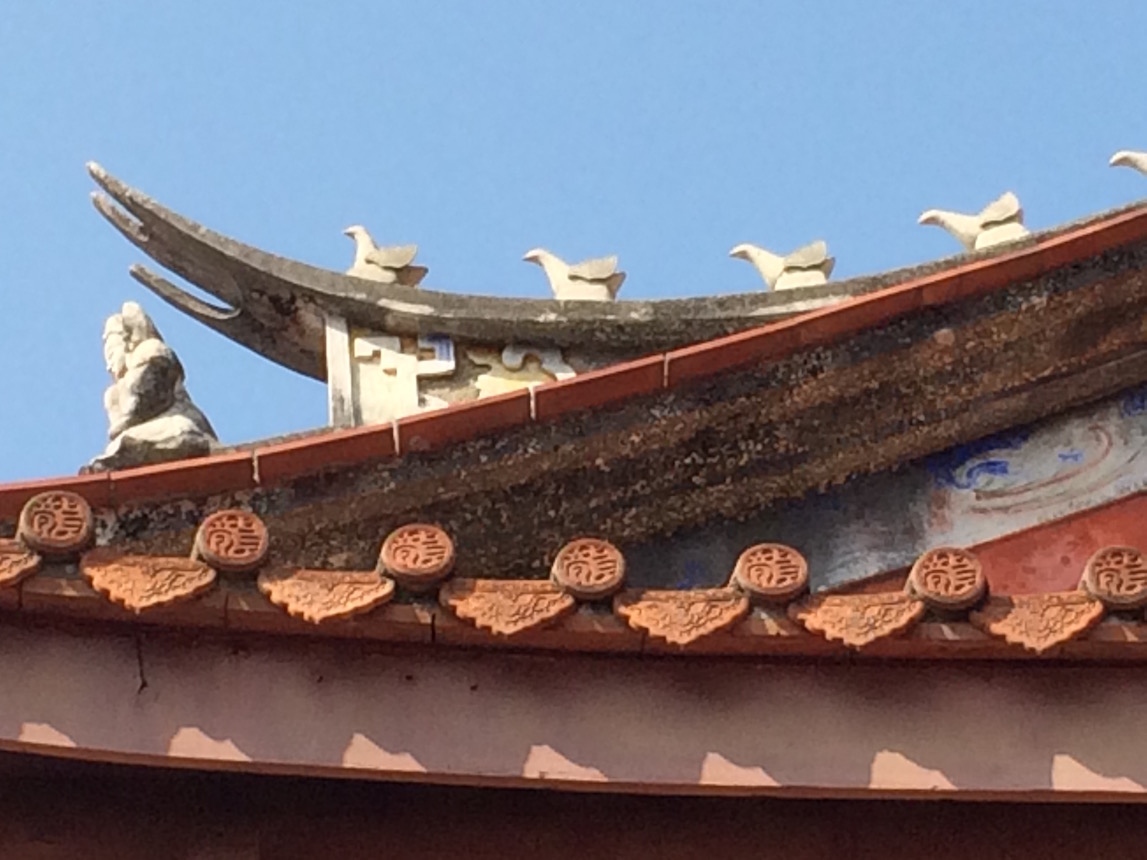As I travel outside Taipei, I’m collecting even more bird stories and images. While in Nantou province in Taiwan’s central mountains, I visited a sculpture park dedicated to self-taught stone-carver Yuan Lin. Guided by Fulbright-Taiwan videographer Sam Chou, I was surprised to find numerous bird-figures, some based on fairy tales that Sam read as a child. One called “Gong Shun” speaks to troubled relations between different groups in old Taiwan. In this tale told by Han immigrants from China, a grandfather and grandson are killed by local indigenous people when they go out to dig bamboo shoots in the forest. They are transformed into cuckoo birds, which ever after return in the spring, along with new bamboo shoots.
Carving by Yuan Lin of a grandfather with grandson on his back, based on Han folktale about the cuckoo
In the Mazu temple museum in Dajia near Taichung, I found my first visual evidence of the birdlike Thunder God, Lei Gong, whose consort is the Goddess of Lightning. In the preserved temple carving, he can be identified among figures on horseback by his wings and telltale green skin color.
Thunder God Lei Gong, a green winged bird-figure seen in temple carving, Dajia museum
At the Mazu temple proper, I was excited to see her sister goddess—really her grandmother—who is more rarely pictured in Taiwan. As Queen Mother of the West, Xi Wangmu is depicted in a huge bronze wall-relief opposite the Sea Goddess, Mazu. They are both majestic, floating across the sky heralded by female attendants carrying wing-like fans, each goddess riding a phoenix.
Relief mural honoring Queen Mother of the West in main hall of Mazu Temple, Dajia
Tainan in the south is the country’s oldest city, housing more than 300 temples, and I found many bird-figures there. Immortals riding birds can be seen on temple doors (sometimes helpfully labeled with Chinese character names); a sage on a crane adds meaning to painted embroidered clothing; and a goddess riding a phoenix floats high above temple decoration.
Tainan temple doors with gods and Immortals, translated by Google as “Ancient Fairies”
Anping temple Door God wears clothing with crane-riding sage holding a peach of longevity
Goddess with flowing drapery on a phoenix atop Tainan temple celebrating with lanterns
At the Tainan Confucius Temple, built in 1665 and famous as the first scholarly academy in Taiwan, I noticed unusual small bird sculptures on the roofline. Inside, a history display explains that Confucian legend says his teaching tamed wild owls to listen. So owls often decorate rooftops of Confucian temples, meaning his teaching is open to all.
Tainan Confucius Temple roofline reveals surprising rows of birds
Ceramic owl roof tile in Confucius Temple museum display—a bird said to have learned from the master
Birds are even visible underfoot in Tainan, on manhole covers. Online research tells me that this represents the Grey Treepie, a bird common in southern Taiwan cities.
Tainan manhole cover design with a Grey Treepie bird









